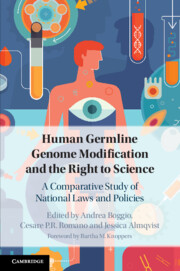 Human Germline Genome Modification and the Right to Science
Human Germline Genome Modification and the Right to Science Book contents
- Human Germline Genome Modification and the Right to Science
- Human Germline Genome Modification and the Right to Science
- Copyright page
- Dedication
- Contents
- Figures
- Tables
- Notes on Contributors
- Foreword
- Preface
- Acknowledgments
- Abbreviations
- 1 Introduction
- 2 The Governance of Human (Germline) Genome Modification at the International and Transnational Levels
- The Regulation of Genome Modification at the National Level
- Part I North America
- Part II Europe
- Part III Asia
- Part IV Other OECD Countries
- 20 The Regulation of Human Germline Genome Modification in Australia
- 21 The Regulation of Human Germline Genome Modification in Israel
- Part V Conclusions
- Index
20 - The Regulation of Human Germline Genome Modification in Australia
from Part IV - Other OECD Countries
Published online by Cambridge University Press: 15 November 2019
- Human Germline Genome Modification and the Right to Science
- Human Germline Genome Modification and the Right to Science
- Copyright page
- Dedication
- Contents
- Figures
- Tables
- Notes on Contributors
- Foreword
- Preface
- Acknowledgments
- Abbreviations
- 1 Introduction
- 2 The Governance of Human (Germline) Genome Modification at the International and Transnational Levels
- The Regulation of Genome Modification at the National Level
- Part I North America
- Part II Europe
- Part III Asia
- Part IV Other OECD Countries
- 20 The Regulation of Human Germline Genome Modification in Australia
- 21 The Regulation of Human Germline Genome Modification in Israel
- Part V Conclusions
- Index
Summary
Australia was at the cutting edge in the development of Artificial Reproductive Technology in the 1960s and 1970s. Regulatory responses were piecemeal: only a small number of the six states and two territories enacted legislation. The regulatory response to reproductive cloning and embryonic stem cell research has been more uniform, with nationally consistent legislation in the form of the Prohibition of Human Cloning for Reproduction Act 2002 and the Research Involving Human Embryos Act 2002, together with the Gene Technology Act 2000. This regulatory regime creates a prohibitory environment for germline genome therapy in Australia and provides little scope for genome editing research involving human embryos, even under licence. This chapter discusses the Australian regulatory regime, with particular focus on this triad of legislative instruments. Although Australia has made a commitment to science and health, and recognition of the right to found a family, the special status of the embryo is a paramount consideration. This chapter concludes that, as in many other countries, Australia is at a crossroads, and Australians must decide, collectively, how far genome editing research involving human embryos should be allowed to progress.
Keywords
- Type
- Chapter
- Information
- Human Germline Genome Modification and the Right to ScienceA Comparative Study of National Laws and Policies, pp. 543 - 567Publisher: Cambridge University PressPrint publication year: 2020
- 1
- Cited by
